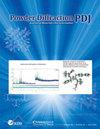Challenges of quantitative phase analysis of iron and steel slags: a look at sample complexity
IF 0.4
4区 材料科学
Q4 MATERIALS SCIENCE, CHARACTERIZATION & TESTING
引用次数: 0
Abstract
Quantitative phase analysis (QPA) of slags is complex due to the natural richness of phases and variability in sample composition. The number of phases frequently exceeds 10, with certain slag types (EAF, BOF, blends, stainless) having extreme peak overlap, making identification difficult. Another convolution arises from the variable crystallite sizes of phases found in slag, as well as the mixture of crystalline and amorphous components specific to each slag type. Additionally, polymorphs are common because of the complexity of the steelmaking and slag cooling processes, such as the cation-doped calcium aluminum silicate (Ca3Al2O6, C3A, Z = 24) supercell in LMF slag. References for these doped variants may not exist or in many cases are not known in advance, therefore it is incumbent on the analyzer to be aware of such discrepancies and choose the best available reference. All issues can compound to form a highly intricate QPA and have prevented previous methods of QPA from accurately measuring phase components in slag. QPA was performed via the internal standard method using 8 wt% ZnO as the internal standard and JADE Pro's Whole Pattern Fitting analysis. For each phase, five variables (lattice parameters, preferred orientation, scale factor, temperature factor, and crystallite size) must be accounted for during quantitation, with a specific emphasis on not refining crystallite sizes for iron oxides and trace phases as they are inclined to over-broaden and interact with the background to improve the goodness of fit (R/E value). Preliminary investigations show somewhat reliable results with the use of custom file sets created within PDF-4+ specifically targeted toward slag minerals to further regulate and normalize the analysis process. The objective of this research is to provide a standard protocol for collecting data, as well as to update methodologies and databases for QPA, to the slag community for implementation in a conventional laboratory setting. Currently, Whole Pattern Fitting “Modified” Rietveld block refinement coupled with the addition of a ZnO internal standard gives the most accurate QPA results, though further research is needed to improve upon the complex issues found in this study of the QPA of slags.铁和钢渣定量相分析的挑战:看样品的复杂性
矿渣的定量相分析(QPA)由于相的自然丰富性和样品组成的可变性而变得复杂。相的数量经常超过10,某些炉渣类型(EAF、BOF、混合物、不锈钢)具有极端的峰值重叠,使得识别变得困难。另一个卷积源于矿渣中发现的相的可变晶粒尺寸,以及每种矿渣类型特有的结晶和非晶成分的混合物。此外,由于炼钢和炉渣冷却过程的复杂性,多晶型物是常见的,例如LMF炉渣中的阳离子掺杂硅酸钙铝(Ca3Al2O6,C3A,Z=24)超级晶胞。这些掺杂变体的参考文献可能不存在,或者在许多情况下事先不知道,因此分析仪有责任意识到这些差异并选择最佳可用参考文献。所有问题都可能复合形成高度复杂的QPA,并阻止了QPA的先前方法准确测量炉渣中的相成分。QPA是通过使用8wt%ZnO作为内标的内标方法和JADE Pro的全模式拟合分析进行的。对于每个相,在定量过程中必须考虑五个变量(晶格参数、优选取向、比例因子、温度因子和晶粒尺寸),特别强调不要细化氧化铁和痕量相的晶粒尺寸,因为它们倾向于过宽并与背景相互作用,以提高拟合优度(R/E值)。初步调查显示,使用PDF-4+中创建的专门针对矿渣矿物的自定义文件集,以进一步规范和规范分析过程,结果在一定程度上是可靠的。本研究的目的是为炉渣社区提供一个收集数据的标准协议,以及更新QPA的方法和数据库,以便在传统实验室环境中实施。目前,全模式拟合“改进”的Rietveld块细化加上ZnO内标的添加,给出了最准确的QPA结果,尽管还需要进一步研究来改进这项矿渣QPA研究中发现的复杂问题。
本文章由计算机程序翻译,如有差异,请以英文原文为准。
求助全文
约1分钟内获得全文
求助全文
来源期刊

Powder Diffraction
工程技术-材料科学:表征与测试
CiteScore
0.90
自引率
0.00%
发文量
50
审稿时长
>12 weeks
期刊介绍:
Powder Diffraction is a quarterly journal publishing articles, both experimental and theoretical, on the use of powder diffraction and related techniques for the characterization of crystalline materials. It is published by Cambridge University Press (CUP) for the International Centre for Diffraction Data (ICDD).
 求助内容:
求助内容: 应助结果提醒方式:
应助结果提醒方式:


